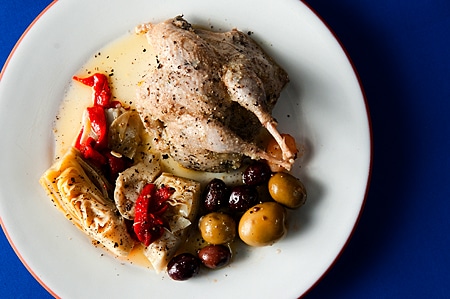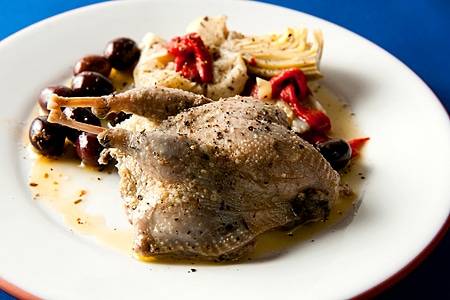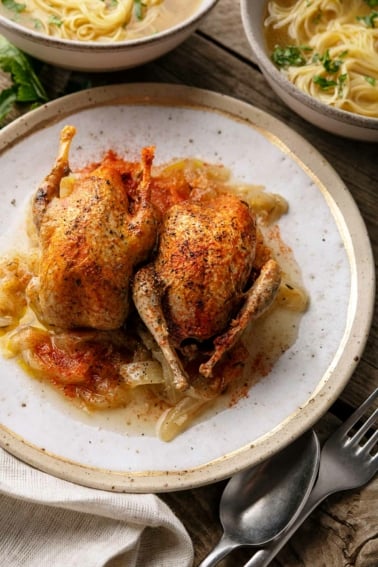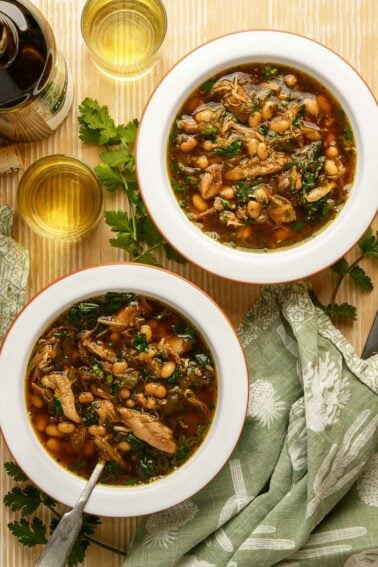As an Amazon Associate I earn from qualifying purchases.

I don’t get many quail in my travels. They are very hard to hunt without a dog, and as a dogless hunter, I rarely target them. My crazed life doesn’t let me have a dog — I travel far too much — but if it did, I would be a quail hunter. They are fast, plentiful here in Northern California, and damn tasty.
But Holly and I did manage to bring home three Valley quail this past season. We were hunting in Amador County with our friend Evan, and were heading off one ranch and to another when we spotted a covey of quail milling around about 100 yards from the truck. Holly and I crept out of the truck and slipped over to the birds.
As it happened, Holly herded them around a pile of boulders and toward me; when they flushed, I got a perfect passing shot. I dropped one, shot in the head. Lucky.
Soon afterward Holly got two more. Almost enough for a full meal! Quail are so small you really need at least two per person for a decent meal, and I’ve eaten four at one sitting without feeling overly bloated. But with only three, what should we do with them?
I remembered that the Greeks preserved small game birds in olive oil, and a look at one of my Greek cookbooks, Diane Kochilas’ The Glorious Foods of Greece, turned up a recipe. My recipe is an adaptation of Diane’s.
Preserving quail like this not only allows you to eat them at your leisure, but it also is a great way to make just a few quail stretch. The birds are traditionally served as a meze, the Greek version of antipasto, with other pickled and preserved things, bread and ouzo or wine.
Even half a preserved quail is a lovely appetizer, and a couple makes a perfect light dinner.
What’s more, you can have them ready whenever you are, as they will last, preserved in jars, more than a month in the fridge and indefinitely in the freezer. Just take the jars out and let them come to room temperature, and then serve.

[recipe_name]Greek preserved quail[/recipe_name]
[summary]The trick to this recipe is to take your time when poaching the quail. You want to cook the quail in hot broth — not simmering, and definitely not boiling, for as long as it takes for the meat to want to fall off the bone.
You can use wild or store-bought quail here, and the recipe should also work with Hungarian partridge and small chukars. Remember domestic birds will cook far faster than their wild cousins.
Make sure your Mason jars are clean before you fill them. I put clean jars in a 225-degree oven for 30 minutes to make sure they are sterile.
You do need a lot of olive oil here, but you can save it when you’ve eaten all your quail and use it to cook with; don’t worry, the quail will already be cooked when they go into the oil, so you need not worry about salmonella. [/summary]
[yield]Serves 4 as an appetizer. [/yield]
Prep Time: [preptime time=10M] 10 minutes, not including the overnight cure. [/preptime]
Cook Time: [cooktime time=2H] 2 hours [/cooktime]
- 4-8 quail
- 1-2 cups kosher salt
- 5 bay leaves
- Zest of an orange, sliced into strips
- 1 dried hot chile, such as a Thai chile
- 2-4 cups of olive oil
___________
[instructions]
- Take each quail and cut out the backbones with kitchen shears or a knife. Discard the backbones, or save for stock. If you want, carefully remove the ribs and saber bone with a sharp knife or shears. Flatten the birds with your hands. Put a layer of salt in a non-reactive container (plastic, glass, stainless steel, etc) and then lay the quail on the salt. Cover with the rest of the salt, making sure it gets into all the crevices on the birds. Cover and store in the fridge overnight.
- The next day, rinse off the salt and put all the birds in a pot and cover with water. Add the bay leaves, orange zest and chile and bring the water to a bare simmer — just a few bubbles on the surface. If you have a thermometer, you want it at about 160-170 degrees. Cover the pot and cook on low heat until the quail are tender, about 2 hours. Older wild quail could take as long as 4 hours, and domestic quail could be tender in 90 minutes. When the birds are tender, turn off the heat and allow the quail to cool in the stock.
- When the birds are at room temperature, remove from the stock (you can save it for soup or for cooking rice) and pat the birds dry. Let them sit out in a breezy place until they quail are dry. It is important for them to be dry, as they will be stored under oil from here on out. When the quail are dry, pack them into clean, sterile Mason jars; I use quart jars so I can jam all four birds in. Cover completely with olive oil. Make sure there are no air bubbles.
- Store in the fridge or anywhere cooler than 50 degrees for at least 2-3 days before eating. They will keep, covered and cool, for a month or more. Or you can freeze them indefinitely.
[/instructions]




Jess: Not really, unless you plan on storing them a LONG time. I usually keep them in a fridge for no more than a week or so.
Hi! Is botulism a concern with this method?
FYI I used my crock pot on low to poach them–it worked really well.
Hank,
have you given thought to revisiting this with your Sous Vide?
Tried it with our Stubble quail here in Australia. Magnificent, thanks. Shared it with friends at last weekend’s duck opening and a hit, even with those not overly keen on the quail.
I love quail! I just wish they were bigger 🙂
Great recipe!
This is a nice greek recipe! The difficult part is to find quails if you are not a hunter…
Travis: Because that’s not how the Greeks do it. It’s different from confit. But a confit of quail would be just as tasty.
Instead of poaching, why not just confit in duck fat or olive oil?
Tyler: I see no reason it wouldn’t work on doves. Only reason I did not do that was because I like my doves cooked medium, and this method requires you to cook them waaay past that.
I’m raising domestic quail right now, and this sounds interesting enough to hold back a few and try it.
Would this recipe work for mourning doves, too? Quail are absent from North Dakota’s landscape, and while we have Hungarian partridge, they are more a bird of happenstance than a species worth targeting. Doves are the only game bird small enough to can around here.
This is such a great idea. I have some quail in my freezer. I love to fry them, but I’ve just felt too lazy to do that after work. I’m going to give this a try.